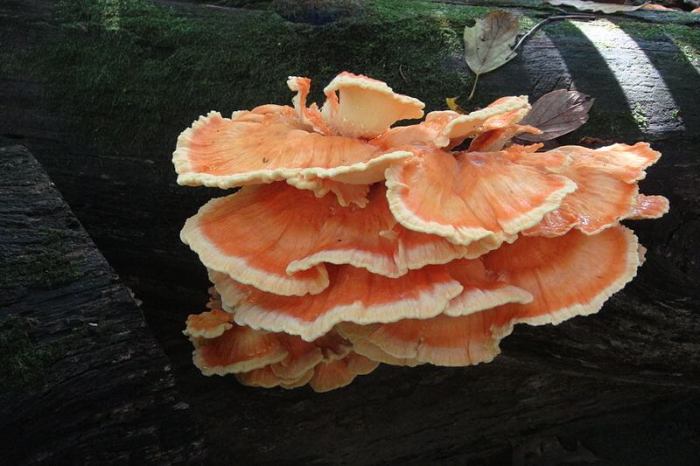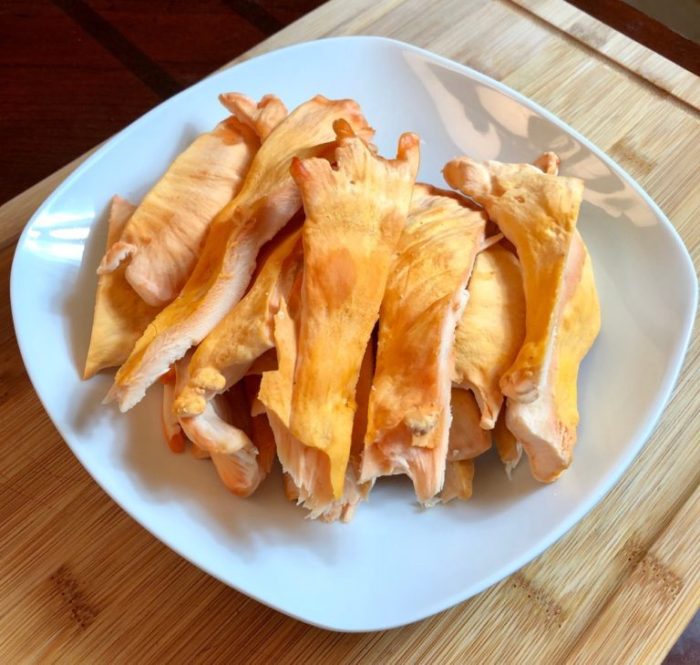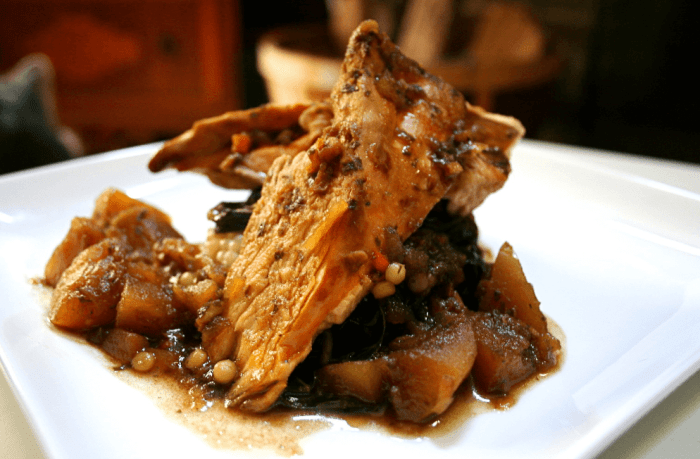
Embark on a culinary adventure with our comprehensive chicken of the woods recipe guide. From identifying and selecting this unique mushroom to exploring its versatile culinary applications, this guide will equip you with the knowledge and inspiration to savor the delectable flavors of chicken of the woods.
Chicken of the Woods Identification and Selection

Chicken of the woods is a distinctive mushroom that resembles a chicken’s comb or coral. It is a polypore, meaning it has pores instead of gills on its underside. The mushroom is typically bright orange or yellow, with a velvety or suede-like texture.
It grows in clusters on the sides of trees, particularly oak trees.
Chicken of the woods is best found in the late summer and fall, after a period of heavy rain. It is important to correctly identify chicken of the woods before consuming it, as there are several poisonous look-alikes. One key difference is that chicken of the woods has white flesh, while poisonous look-alikes often have yellow or orange flesh.
Physical Characteristics
- Bright orange or yellow color
- Velvety or suede-like texture
- Grows in clusters on the sides of trees
- Has pores instead of gills on its underside
- White flesh
Ideal Conditions for Foraging
Chicken of the woods is most commonly found in hardwood forests, particularly oak forests. It prefers warm, humid climates and grows best after a period of heavy rain. The mushroom can be found in both urban and rural areas, but it is more common in areas with less human disturbance.
Best Time of Year to Find It, Chicken of the woods recipe
Chicken of the woods is typically found in the late summer and fall, from August to November. However, it can sometimes be found earlier or later in the year, depending on the weather conditions.
Importance of Correct Identification
It is important to correctly identify chicken of the woods before consuming it, as there are several poisonous look-alikes. One key difference is that chicken of the woods has white flesh, while poisonous look-alikes often have yellow or orange flesh.
Other poisonous look-alikes may have a bitter taste or a slimy texture.
Cleaning and Preparation Techniques

To prepare chicken of the woods for cooking, it is essential to clean and prepare it properly. This involves removing dirt and debris, as well as cutting and slicing it to the desired size. Additionally, there are techniques for preserving chicken of the woods for future use, such as drying or freezing.
Cleaning Chicken of the Woods
- Brushing:Use a soft-bristled brush to gently remove any dirt or debris from the surface of the mushroom.
- Rinsing:Rinse the mushroom briefly under cold running water to remove any remaining dirt or debris. Avoid soaking the mushroom, as it can absorb water and become soggy.
- Trimming:Trim away any tough or woody parts of the mushroom, such as the base or the edges.
Cutting and Slicing Chicken of the Woods
- Slicing:Cut the mushroom into thin slices for sautéing or stir-frying.
- Dicing:Cut the mushroom into small cubes for use in soups, stews, or casseroles.
- Shredding:Use your fingers or a fork to shred the mushroom into thin strips for use in salads or sandwiches.
Preserving Chicken of the Woods
- Drying:Cut the mushroom into thin slices and dry them in a dehydrator or in a warm, dry place. Dried chicken of the woods can be stored in an airtight container for up to a year.
- Freezing:Cut the mushroom into slices or cubes and freeze them in an airtight container. Frozen chicken of the woods can be stored for up to six months.
Culinary Applications and Flavor Profile
Chicken of the woods is a versatile culinary delight that boasts a unique flavor and texture. Its meaty, firm texture resembles chicken, while its flavor profile is earthy, nutty, and slightly peppery. This distinct combination makes it a popular choice for various cooking methods.
Sautéing
Sautéing chicken of the woods is a quick and easy way to enjoy its savory flavor. Simply heat a pan with oil, add the chicken of the woods, and cook until golden brown. Season with salt and pepper to taste, and serve as a side dish or over pasta or rice.
If you’re looking for a unique and flavorful meal, try out the chicken of the woods recipe . This edible mushroom has a meaty texture and a mild, nutty flavor. It’s a great way to add some variety to your vegetarian or vegan diet.
Roasting
Roasting chicken of the woods intensifies its earthy flavor. Preheat the oven to 400°F (200°C) and toss the chicken of the woods with olive oil, salt, and pepper. Roast for 20-25 minutes, or until tender and slightly crispy. Serve as a side dish or as part of a main course.
Grilling
Grilling chicken of the woods is a great way to impart a smoky flavor. Preheat the grill to medium-high heat and brush the chicken of the woods with oil. Grill for 5-7 minutes per side, or until cooked through. Serve with grilled vegetables or as a topping for burgers or tacos.
Soups and Stews
Chicken of the woods adds a hearty and flavorful addition to soups and stews. Simply add the chicken of the woods to the soup or stew during the last 15-20 minutes of cooking. Its meaty texture will hold up well and its earthy flavor will complement the other ingredients.
Nutritional Value and Health Benefits: Chicken Of The Woods Recipe

Chicken of the woods is a nutritionally rich mushroom, offering a substantial amount of protein, fiber, and vitamins. It is a low-calorie food, containing only about 25 calories per 100 grams.
For a more traditional twist, try the chicken of the woods recipe with a creamy mushroom sauce. This dish is sure to impress your guests with its rich and savory flavors.
Protein is essential for building and repairing tissues in the body. Chicken of the woods is a good source of protein, containing about 3 grams per 100 grams. This makes it a valuable plant-based protein source for vegetarians and vegans.
Fiber is important for maintaining a healthy digestive system. It helps to regulate bowel movements and can help to lower cholesterol levels. Chicken of the woods is a good source of fiber, containing about 2 grams per 100 grams.
Chicken of the woods is also a good source of vitamins, including vitamin C, vitamin D, and niacin. Vitamin C is an antioxidant that helps to protect the body from damage caused by free radicals. Vitamin D is important for bone health.
Niacin is a B vitamin that is essential for energy production.
Health Benefits
In addition to its nutritional value, chicken of the woods has also been shown to have several potential health benefits. These benefits include:
- Antioxidant activity:Chicken of the woods contains several antioxidants, including ergothioneine and glutathione. These antioxidants help to protect the body from damage caused by free radicals. Free radicals are unstable molecules that can damage cells and DNA, leading to chronic diseases such as cancer and heart disease.
- Anti-inflammatory activity:Chicken of the woods has also been shown to have anti-inflammatory properties. Inflammation is a natural response to injury or infection, but chronic inflammation can lead to several health problems, including heart disease, cancer, and arthritis.
- Immune-boosting activity:Chicken of the woods contains several compounds that can help to boost the immune system. These compounds include polysaccharides and beta-glucans. Polysaccharides are complex carbohydrates that help to activate the immune system. Beta-glucans are a type of fiber that has been shown to have antiviral and antibacterial properties.
Several research studies have supported the health claims associated with chicken of the woods. For example, a study published in the journal “Food Chemistry” found that chicken of the woods extract had strong antioxidant and anti-inflammatory properties. Another study, published in the journal “Mycobiology,” found that chicken of the woods extract had immune-boosting effects.Overall,
chicken of the woods is a nutritious and healthy mushroom that offers several potential health benefits. It is a good source of protein, fiber, and vitamins, and it has been shown to have antioxidant, anti-inflammatory, and immune-boosting properties.
Cultivation and Sustainability
Chicken of the woods cultivation methods are still under development, but researchers and mushroom enthusiasts are making progress. Substrate preparation involves creating a growth medium that mimics the natural habitat of chicken of the woods. This typically involves a mixture of sawdust, wood chips, or other organic materials.
The substrate is then inoculated with chicken of the woods spores or mycelium.Sustainable foraging practices are essential for preserving chicken of the woods populations. Avoid harvesting from areas where the mushrooms are scarce or appear stressed. Only harvest mature mushrooms and leave the younger ones to grow and reproduce.
Avoid disturbing the mycelium network by digging up the mushrooms; instead, cut them off at the base.
Final Thoughts

Whether you’re a seasoned forager or a culinary enthusiast seeking new culinary horizons, our chicken of the woods recipe guide empowers you to unlock the full potential of this woodland delicacy. Embrace the joy of foraging, savor the distinct flavors of chicken of the woods, and nourish your body with its nutritional benefits.
Happy foraging and feasting!
Questions and Answers
What are the look-alikes of chicken of the woods?
False chicken of the woods (Laetiporus sulphureus) and sulfur shelf (Laetiporus conifericola) are similar in appearance but have different colors and grow on different substrates.
How can I preserve chicken of the woods for later use?
Drying or freezing are effective methods for preserving chicken of the woods. Drying concentrates its flavor, while freezing maintains its texture and nutrients.
What are the health benefits of chicken of the woods?
Chicken of the woods is rich in protein, fiber, vitamins, and antioxidants. It has potential anti-inflammatory and antimicrobial properties.





